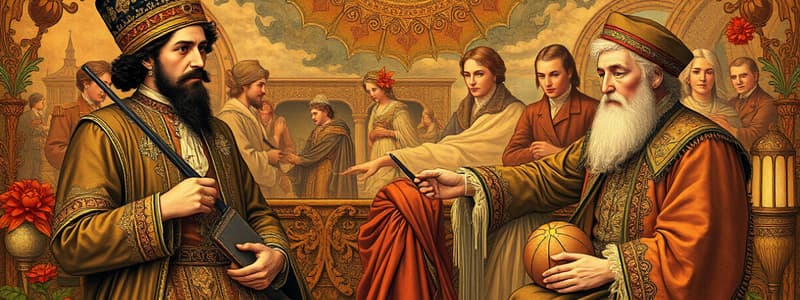Podcast
Questions and Answers
Who was Alfred Thayer Mahan?
Who was Alfred Thayer Mahan?
- A U.S. president
- A United States Navy officer (correct)
- A Filipino leader
- A Spanish governor
What nickname was given to Valeriano Weyler?
What nickname was given to Valeriano Weyler?
The Butcher
What did Dupuy de Lóme do?
What did Dupuy de Lóme do?
Wrote a private letter criticizing President McKinley
Theodore Roosevelt was the 26th president of the United States.
Theodore Roosevelt was the 26th president of the United States.
What is Emilio Aguinaldo known for?
What is Emilio Aguinaldo known for?
What policy did 'Reconcentration' refer to?
What policy did 'Reconcentration' refer to?
Define jingoism.
Define jingoism.
Imperialism is a policy in which a strong nation seeks to dominate other countries __________.
Imperialism is a policy in which a strong nation seeks to dominate other countries __________.
Guerrilla warfare involves direct engagement with the enemy.
Guerrilla warfare involves direct engagement with the enemy.
What does 'Spheres of Influence' refer to?
What does 'Spheres of Influence' refer to?
What was the main purpose of the Pan-American Conference?
What was the main purpose of the Pan-American Conference?
What did the Teller Amendment promise?
What did the Teller Amendment promise?
What did the Treaty of Paris (1898) conclude?
What did the Treaty of Paris (1898) conclude?
What was the Anti-Imperialist League's main objection?
What was the Anti-Imperialist League's main objection?
What was the Boxer Rebellion?
What was the Boxer Rebellion?
Who led the Rough Riders?
Who led the Rough Riders?
What does the term 'Big-Stick Rebellion' refer to?
What does the term 'Big-Stick Rebellion' refer to?
Describe the Panama Canal.
Describe the Panama Canal.
What did the Roosevelt Corollary assert?
What did the Roosevelt Corollary assert?
What was the Gentlemen's Agreement?
What was the Gentlemen's Agreement?
What was the purpose of the Great White Fleet?
What was the purpose of the Great White Fleet?
What was the Russo-Japanese War about?
What was the Russo-Japanese War about?
What does a missionary do?
What does a missionary do?
What is the 'White Man's Burden'?
What is the 'White Man's Burden'?
Who were the Insurrectos?
Who were the Insurrectos?
Define expansionism.
Define expansionism.
Flashcards are hidden until you start studying
Study Notes
Key Figures in U.S. Expansionism
- Alfred Thayer Mahan: Influential U.S. Navy officer and geostrategist; authored The Influence of Seapower Upon History, 1660-1783 in 1890, advocating for naval power leading to pre-WWI buildups.
- Valeriano Weyler: Spanish governor infamous for brutal tactics against Cuban rebels, earning the moniker "Butcher."
- Dupuy de Lóme: Spanish minister whose derogatory letter about President McKinley escalated tensions prior to the Spanish-American War.
- Theodore Roosevelt: 26th U.S. president noted for conservation efforts, the Hepburn Act, the Panama Canal, and receiving the Nobel Peace Prize for mediating the Russo-Japanese War.
- George Dewey: U.S. naval officer celebrated for his decisive victory at the Battle of Manila Bay during the Spanish-American War.
- Emilio Aguinaldo: Leader of the Filipino independence movement; declared independence in 1899 but was captured by U.S. forces by 1901.
- William Howard Taft: 27th U.S. president and later chief justice of the Supreme Court.
Policies and Concepts
- Reconcentration: Policy to confine Cuban civilians in camps to inhibit support for rebel factions.
- Jingoism: Extreme nationalism promoting aggressive foreign policy.
- Imperialism: Expansionist policy where strong nations dominate weaker countries politically, socially, and economically.
- Guerrilla Warfare: Non-traditional warfare tactic involving ambush and hit-and-run strategies rather than direct confrontation.
Historical Context
- Spheres of Influence: Designates areas controlled by foreign nations without direct governance (i.e., European and U.S. interests in China).
- Yellow Peril: Racial metaphor referencing fears surrounding Chinese immigration and influence in the late 19th century.
- Pan-American Conference: Initiative led by James Blaine to enhance trade relations and cooperation among the Americas.
Major Events and Legislation
- Teller Amendment: Commitment by the U.S. not to annex Cuba after the Spanish-American War victory.
- Treaty of Paris (1898): Ended the Spanish-American War, granting the U.S. Guam, Puerto Rico, and purchasing the Philippines for $20 million.
- Anti-Imperialist League: Coalition opposing annexation of the Philippines and imperialism, motivated by a range of ideals including racism and constitutionalism.
- Philippine Insurrection: Conflict emerging after the U.S. annexation, marked by hostilities between U.S. troops and Filipino nationalists.
- Boxer Rebellion: 1900 uprising in China against foreign influence, contributing to tensions in imperial territories.
Military Strategies and Agreements
- Rough Riders: Volunteer regiment led by Roosevelt during the Spanish-American War, notable for their charge up San Juan Hill.
- Big-Stick Diplomacy: Roosevelt's approach to foreign policy, emphasizing military readiness to enforce U.S. interests, a continuation of the Monroe Doctrine.
- Panama Canal: Major engineering project completed between 1904 and 1914, facilitating maritime trade and military movement.
- Roosevelt Corollary: Extension of the Monroe Doctrine, justifying U.S. intervention in Latin America to protect economic interests.
- Gentlemen's Agreement: Accord with Japan to limit immigration of laborers while allowing families of existing immigrants to reunite.
- Great White Fleet: Naval deployment (1907-1909) to showcase U.S. naval strength globally, and exert pressure on Japan concerning immigration issues.
- Russo-Japanese War: Conflict over imperial interests in Asia (1904-1905); Roosevelt mediated peace, winning the Nobel Prize for his diplomacy.
Ideologies and Movements
- Missionary: Individuals seeking to convert others to particular beliefs or ideologies, especially in the context of U.S. cultural expansion.
- White Man's Burden: Justification for imperialism, suggesting it was the moral duty of white nations to civilize non-white populations.
- Insurrectos: Cuban or Filipino rebels employing scorched earth tactics against colonial powers to assert independence.
- Expansionism: Doctrine promoting territorial and economic growth of a nation beyond its borders.
Studying That Suits You
Use AI to generate personalized quizzes and flashcards to suit your learning preferences.




